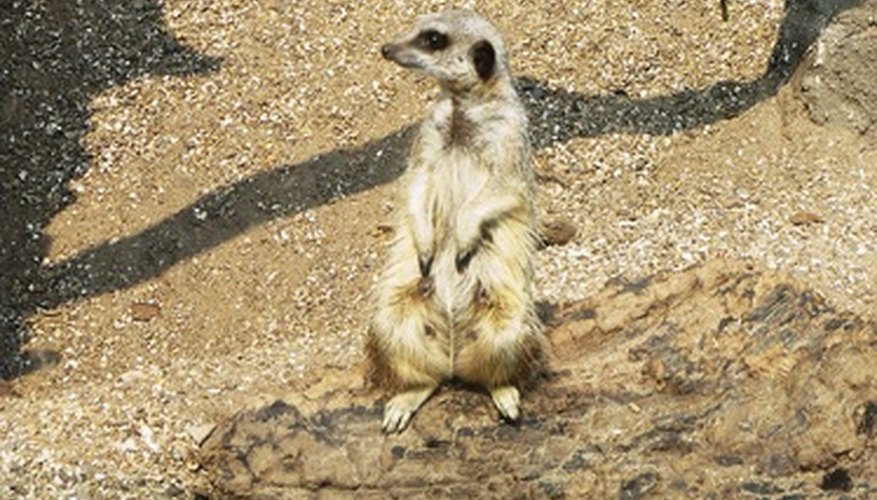Meerkats, or suricates, are squirrel-size mammals that live in the southern African plains. Similar in appearance to American prairie dogs, meerkats are in the mongoose family. They are omnivores, meaning they eat plants and meat, and they live in large groups of many families. Gregarious creatures, meerkats have been subject to a popular Animal Planet series called "Meerkat Manor," which feature different generations and families of meerkats and their antics. You can make your own wildlife diorama, or 3-D model, of this small animal by modifying a box and recreating its habitat.
- Meerkats, or suricates, are squirrel-size mammals that live in the southern African plains.
- You can make your own wildlife diorama, or 3-D model, of this small animal by modifying a box and recreating its habitat.
Sketch a drawing of how you want your diorama to look. Use a reference photo that depicts a meerkat in its natural habitat, the plains of southern Africa. Be sure to include tall grasses, a model of a meerkat and other distinguishing traits. A diorama is a three-dimensional model, and you can depict higher terrain and lower areas. Also, your concept should incorporate a specific view of a meerkat's natural environment. Consider including an entrance burrow, where they live.
List the different elements you are depicting in your diorama, such as grass, higher terrain, sand, Meerkat, burrow, and others. This list will help you plan what items you need to purchase to recreate each element. An arts and crafts store or a modelling store will have many of the items you will need. The structure of your diorama can be a medium to large cardboard box.

Cut off the opening flaps of one side of your box with your utility knife, so you have five sides left. Place the box down on one of the long sides, so it is open facing you.
Crush newspapers and place them in your diorama for the ground. Ball newspapers together for higher terrain, and roll together newspaper for an entrance to a burrow. Tape the newspaper down with masking tape. Tear off strips of newspaper to use for paper mache for the ground.
- List the different elements you are depicting in your diorama, such as grass, higher terrain, sand, Meerkat, burrow, and others.
- Crush newspapers and place them in your diorama for the ground.
Mix together one part water to one part flour in a mixing bowl to make paper mache paste. Be sure the paste is thick like porridge. You can add more flour or water to get the desired consistency. Dip your newspaper strips to saturate with the paste, and lay the strips over the newspapers you crumbled for the terrain and burrow. Let dry 24 hours. Add another layer, and then let dry 24 hours. Add a third and final layer and then let dry for 24 hours.
- Mix together one part water to one part flour in a mixing bowl to make paper mache paste.
- Add another layer, and then let dry 24 hours.
Paint areas that will have grass green. Paint areas that will be sand, a tan colour. Paint grey in areas you will have stones or gravel.
- Paint areas that will have grass green.
- Paint grey in areas you will have stones or gravel.
Brush on glue on the green painted areas with a painter's brush. If your glue is too thick, you can add a little water to it. Shake on coarse turf material, purchased from a modelling or crafts store.
Brush glue onto the tan areas and sprinkle fine sand over the glue. Glue in place small pebbles from your garden. You can also purchase gravel for your diorama. Glue down model tall grass onto your diorama too.

Sculpt a Meerkat from air-dry clay. Be sure to keep the size of your Meerkat in the same scale as your diorama. Use a plastic knife to create texture for the fur. Let it dry completely, before painting it with the appropriate colours. Glue into place to complete your Meerkat diorama.
TIP
Experiment with different textures and elements for your diorama. This is a simple blueprint for a diorama, you can make a larger scene with trees and a whole family. You can also apply fake fur to your Meerkat to make it look more realistic.
WARNING
Be sure to use newspapers or dust sheet on your table and floor to protect them from paint and glue. Keep pets away from paper mache paste. Some dogs like eating it.
